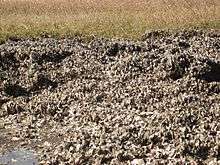Crassostrea
Crassostrea is a genus of true oysters (family Ostreidae) containing some of the most important oysters used for food. Some species in the genus have been moved to the genus Magallana.
| Crassostrea | |
|---|---|
 | |
| Eastern oyster bed on Cockspur Island, Georgia, USA | |
| Scientific classification | |
| Kingdom: | Animalia |
| Phylum: | Mollusca |
| Class: | Bivalvia |
| Order: | Ostreida |
| Family: | Ostreidae |
| Genus: | Crassostrea Sacco, 1897[1] |
| Species | |
|
See text | |
| Synonyms | |
| |
Species
Extant species
Extant species include:[2]
- Crassostrea aequatorialis (d'Orbigny 1846)[2]
- Crassostrea angulata (Lamarck 1819) – Portuguese oyster
- Crassostrea brasiliana (Lamarck 1819)[2]
- Crassostrea chilensis (Philippi 1845)
- Crassostrea columbiensis (Hanley 1846)[2]
- Crassostrea corteziensis (Hertlein 1951)
- Crassostrea cuttackensis (Newton & Smith, 1912)
- Crassostrea dianbaiensis (Xia, Wu, Xiao & Yu, 2014)
- Crassostrea rhizophorae (Guilding 1828)[2]
- Crassostrea sikamea (Amemiya 1928) – Kumamoto oyster
- Crassostrea tulipa (Lamarck 1819) – mangrove oyster[2]
- Crassostrea virginica (Gmelin 1791) – Eastern oyster[2]
Fossil species[3]
Crassostrea gigantissima (Finch, 1824) right valve interior (Eocene of Texas).
- †Crassostrea alabamiensis (Lea 1833)
- †Crassostrea ashleyi (Hertlein 1943) (syn. Ostrea arnoldi)
- †Crassostrea cahobasensis (Pilsbry and Brown 1910)
- †Crassostrea contracta (Conrad 1865)
- †Crassostrea cucullaris (Lamarck 1819)
- †Crassostrea cuebana (Jung 1974)
- †Crassostrea elegans (Deshayes, 1832)[4] (syn. †Cubitostrea elegans Deshayes 1832 or Crassostrea (Cubitostrea) elegans)
- †Crassostrea gigantissima (Finch 1824) – Giant fossil oyster
- †Crassostrea gryphoides (Schlotheim 1813)
- †Crassostrea hatcheri (Ihering 1899)
- †Crassostrea ingens (Zittel 1864)
- †Crassostrea kawauchidensis (Tamura 1977)
- †Crassostrea patagonica (d'Orbigny 1842) (syn. Ostrea ferrarisi)
- †Crassostrea raincourti (Deshayes 1858)
- †Crassostrea titan (Conrad 1853) (syn. Ostrea prior, O. andersoni)
- †Crassostrea transitoria (Hupé 1854) (syn. Ostrea maxima)
- †Crassostrea wyomingensis[5]
Genetics
The genome of Crassostrea gigas (now Magallana gigas) has been recently sequenced revealing an extensive set of genes that enable it to cope with environmental stresses.[6]
gollark: Weird.
gollark: Perhaps specifying that makes it switch to a less fuzzy search thing.
gollark: If this octal status code thing exists, which I can't confirm.
gollark: I bet you can somehow do exploity things based on browsers and other things recognising status codes in weird formats differently.
gollark: Site-19.
References
- Crassostrea on britannica.com.
- I Molluschi dei terreni terziari del Piemonte e della Liguria. F Sacco, 1897
- Taxon list for Crassostrea. World Register of Marine Species, accessed on 9 August 2017.
- "†Crassostrea Sacco 1897". Paleobiology Database. Fossilworks. Retrieved 29 April 2010.
- irmng
- J. Haffty, R. G. Schmidt, L. B. Riley, W. D. Goss. Rocks and Mineral Resources of the Wolf Creek Area, Lewis and Clark and Cascade Counties, Montana: A Descriptive Report on an Area in the Disturbed Belt Along the Eastern Front of the Northern Rocky Mountains in Western Montana, Issues 1441-1446
- Zhang, G.; Fang, X.; Guo, X.; Li, L.; Luo, R.; Xu, F.; Yang, P.; Zhang, L.; Wang, X.; Qi, H.; Xiong, Z.; Que, H.; Xie, Y.; Holland, P. W. H.; Paps, J.; Zhu, Y.; Wu, F.; Chen, Y.; Wang, J.; Peng, C.; Meng, J.; Yang, L.; Liu, J.; Wen, B.; Zhang, N.; Huang, Z.; Zhu, Q.; Feng, Y.; Mount, A.; Hedgecock, D. (2012). "The oyster genome reveals stress adaptation and complexity of shell formation". Nature. 490 (7418): 49–54. Bibcode:2012Natur.490...49Z. doi:10.1038/nature11413. PMID 22992520.
This article is issued from Wikipedia. The text is licensed under Creative Commons - Attribution - Sharealike. Additional terms may apply for the media files.